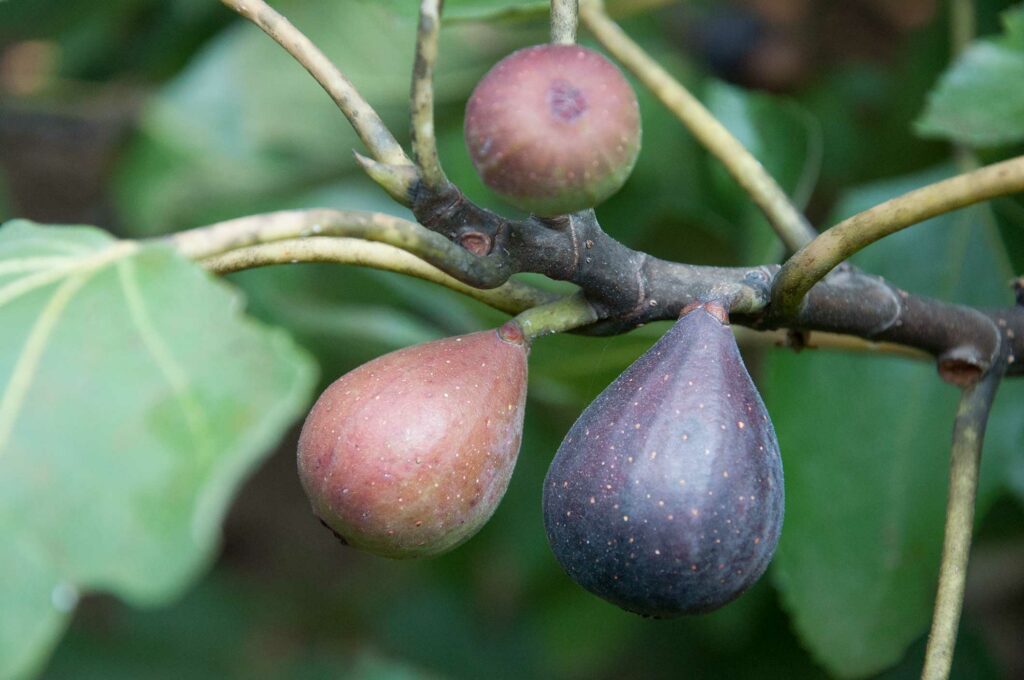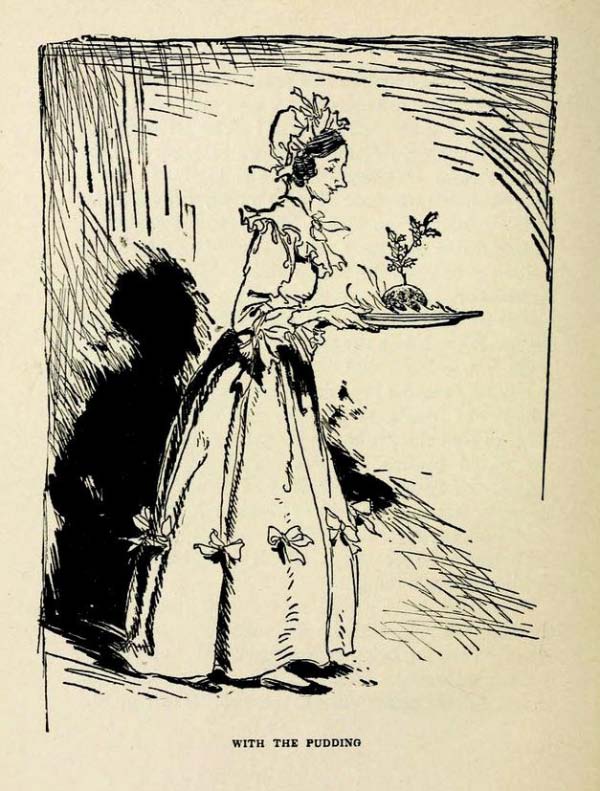
Thanksgiving is here, and we’ll soon enter the Advent season leading up to Christmas. I’ve never had it, but I understand a festive dish known as “figgy pudding” originated in medieval times and was especially popular in Victorian England.
It’s the dessert that Bob Cratchit and his family enjoy as part of their Christmas celebration, as depicted in the 1984 movie version of “A Christmas Carole” featuring George C. Scott as “Scrooge.” (It’s one of my Christmas movie favorites, by the way.)

The scene in the movie is heartwarming and a little ‘suspenseful.’ As Dickens wrote in the book,
But now, the plates being changed by Miss Belinda, Mrs. Cratchit left the room alone—too nervous to bear witnesses— to take the pudding up and bring it in.
—“A Christmas Carol,” from The Works of Charles Dickens, Volume 13
Suppose it should not be done enough! Suppose it should break in turning out! Suppose somebody should have got over the wall of the back-yard, and stolen it, while they were merry with the goose—a supposition at which the two young Cratchits became livid. All sorts of horrors were supposed.
Hallo! A great deal of steam. The pudding was out of the copper. A smell like a washing-day! That was the cloth. A smell like an eating-house and a pastrycook’s next door to each other, with a laundress’s next door to that! That was the pudding ! In half a minute Mrs. Cratchit entered—flushed, but smiling proudly —with the pudding, like a speckled cannon-ball, so hard and firm, blazing in half of half-a-quartern of ignited brandy, and bedight with Christmas holly stuck into the top.
Oh, a wonderful pudding ! Bob Cratchit said, and calmly too, that he regarded it as the greatest success achieved by Mrs. Cratchit since their marriage. Mrs. Cratchit said that now the weight was off her mind, she would confess she had had her doubts about the quantity of flour. Everybody had something to say about it, but nobody said or thought it was at all a small pudding for a large family. It would have been flat heresy to do so. Any Cratchit would have blushed to hint at such a thing. At last the dinner was all done, the cloth was cleared, the hearth swept, and the fire made up.


The Food Network describes figgy pudding this way:
Sometimes known as Christmas pudding or plum pudding, figgy pudding is a steamed cake-like dessert made from dried fruit, flour, suet or butter and brown sugar, and typically soaked in brandy or rum. Records of figgy pudding or similar dishes date to England circa 1400 and consist of a mixture of boiled figs, wine, ground almonds and honey, and sometimes more savory ingredients.
I wouldn’t mind giving figgy pudding a try. I like Fig Newton cookies, so perhaps it tastes similar. When the Cratchits eat it in the movie, they use a spoon to scoop some gooey stuff from the center, so I’m not sure. My wife likes to eat figs themselves.
Not surprisingly, since they’re native to the Mediterranean region, references to fig trees occasionally appear in the Bible.
One “figgy” story is found in two Gospels: Matt. 21:18-22 and Mark 11:12-14. It’s part of the events surrounding Jesus’s entry into Jerusalem (Palm Sunday). In the story, Jesus curses a fig tree, not because he doesn’t like figgy pudding, but because he’s hungry and goes to one to pick some fruit, only to find none.
It’s strange—why would the Son of God get angry with a fig tree? After all, it was just doing what fig trees do, sometimes producing fruit and sometimes not. Mark 11:13 explains that “it was not the season for figs.”
It seems to me Jesus should’ve known that. He created the seasons, after all, and the fig tree, for that matter.
The gospel accounts are slightly different, but there is a question that comes to mind in both that we need to answer: Why did Jesus curse the fig tree? If he was “hangry,” he could’ve just had a Snickers candy bar or a pack of Fig Newtons instead.
Well, as is often the case, there’s much more to this story and Jesus’ actions than meets the eye.
The answer lies in the symbolism of the fig tree. It was considered a sign of blessing and prosperity for Israel. An unfruitful or dead fig tree would have represented the spiritual deadness of Israel. In this surprising story, which happens in conjunction with Jesus’ cleansing of the Temple after entering Jerusalem with much adulation and worship (as a messianic ruler-king), Jesus further announces his spiritual authority by cursing the fig tree, causing it to die.
In effect, he was pronouncing judgment on Israel and its religious leaders (who were pretty riled up by this time), not because he wasn’t getting any figgy pudding. He condemned outward religious displays and observances without the fruit of genuine salvation. And as we know, the leaders eventually called for his execution—they were riled up indeed!
As mentioned, the fig tree is a sign of fruitfulness and blessing. But, as Jesus discovered, sometimes the tree is bare. But the prophet Habakkuk describes a situation that sounds much more dire:
For though the fig tree shall not flourish, neither shall fruit be in the vines; The labor of the olive shall fail, And the fields shall yield no food; The flock shall be cut off from the fold, And there shall be no herd in the stalls: Yet I will rejoice in Jehovah, I will joy in the God of my salvation. (Hab. 3:17-18)
Here, the bare tree and vine are indicative of bad times. But as a prophet of God, Habakkuk could see through the pretty gloomy situation at the time and see God’s ultimate plan and purpose at work. And despite what we see, read, and hear, God’s mighty—and sometimes mysterious—hand is at work in our own strange and perplexing times, just as in Habakkuk’s.
At the beginning of his prophecy, Habakkuk registered a complaint with God:
O Lord, how long shall I cry for help, and you will not hear? Or cry to you “Violence!” and you will not save? Why do you make me see iniquity, and why do you idly look at wrong? Destruction and violence are before me; strife and contention arise. (Hab. 1:2-3)
This is the cry of many Christians living in the world today. The Lord answered Habakkuk’s complaint this way:
Look among the nations, and see; wonder and be astounded. For I am doing a work in your days that you would not believe if told. (Hab. 1:5)
You see, even when it looks like God doesn’t know what he’s doing, that he’s not being a very good God, and that if we were God, we would do things differently, and when we begin to doubt God’s goodness and wisdom, he reminds us that he is God and we are not and that we need to trust him because he knows what he’s doing.
Christians hope and pray for divine intervention in the messed-up world we live in. Habakkuk, grappling with his hope for Israel amid despair, offers us hope: “Yet I will rejoice in Jehovah, I will joy in the God of my salvation.”
How could he do that?
As we perceive it through headlines and experience it in everyday life, the world appears broken, burdened with sin, and offers countless reasons for sorrow. In the face of such circumstances, in this season of Thanksgiving, why would rational individuals pause to express hope, gratitude, and joy to a God who seemingly is letting the world spin out of control?
In Habakkuk’s time, God had a plan at work even amid the coming devastation of Babylon. The Lord was working things out for his eternal, sovereign, saving purpose, even if Habakkuk could completely understand it and would have to wait to see that plan’s end and final outcome. As the Lord said to him,
Write the vision; make it plain on tablets, so he may run who reads it. For still the vision awaits its appointed time; it hastens to the end–it will not lie. If it seems slow, wait for it; it will surely come; it will not delay. (Hab. 2:2-4)
The same is true today, no matter what the headlines say. We can endure difficult and challenging times by trusting in the Lord’s sovereignty and promises, even though it means waiting. “The righteous shall live by his faith,” Habakkuk famously wrote. And it’s as true now as it was then.
Back then, the people of Judah had to wait 70 years for the end of the Babylonian Captivity. And then it would be another 500 years till the coming of the promised deliverer, the Messiah. But Habakkuk did see that salvation coming. He prays to the Lord: “You went out for the salvation of your people, for the salvation of your anointed.” Yes, God has not forgotten his people; he has not forgotten his promise.
That promise would be ultimately fulfilled, of course, in the coming of the Christ, our Lord Jesus Christ, who is the salvation of God come in the flesh. He is the answer to all our temptations to fear and anxiety. He is the one who controls the future; indeed, he is our future!
And what is this salvation that has come in Christ? It is forgiveness for all of our sins, our sins that deserve God’s judgment and wrath. But, instead of falling on us, that judgment fell on Christ, on the cross, in our place (2 Cor. 5:21). It is the resurrection of our bodies, restored and glorified, ready for the eternal life we will enjoy with our Lord in glory, along with Habakkuk and Hosea and Haggai and all those other Old Testament guys from way back when, as well as saints of more recent times (1Cor. 15:35-58). They’ll all be there, with you and me, giving thanks forever to our gracious God and Savior.
And we’ll all be enjoying figs from the fig trees that grow twelve months a year along the river of the water of life in New Jerusalem. (And, who knows, maybe some figgy pudding too!)
Thanksgiving offers us the opportunity to lift our gaze beyond the sadness and sorrows of our broken world and toward God, Jesus, and the Gospel with profound gratitude for his gift of salvation through our Lord and Savior Jesus Christ. One of my pastors wrote the following:
The manifold blessings of the gospel are ours as an undeserved and free gift from our gracious God. The only appropriate response to such generous grace is gratitude: gratitude that is cultivated and grows the more we remember, understand, and appreciate all those gospel benefits.
In light of this, Paul says that we should be “giving thanks always and for everything to God the Father in the name of our Lord Jesus Christ” (Eph, 5:20). Yes, Thanksgiving is a special day to remember all of God’s blessing, but let us thank God every day for the glorious hope we have in his Son because that hope remains sure in this age, even when there are no figs on the fig trees, and in the age to come when they are covered entirely with them. Let us be thankful, rejoice, and have another spoon of figgy pudding, for our salvation draws near (Rom. 13:11-12)!
